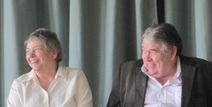Kay and Michael Dennis who specialise in stumpwork talked to the Guild this month. Kay explained that stumpwork is a mixture of embroidery worked on the surface, padded work and some free standing.
Kay and Michael have written three books on stumpwork and Kay explained how she first got interested. When she was only 4 years old she was sent to visit her aunt while her parents moved house and those few days had a major effect on her life when she was introduced to embroidery.
When she got older she went to a class on needle lace and after attending a talk by Barbara & Roy Hirst she was enthralled by their work and became “one of their groupies”.
Michael retired 18 years ago and became a professional wood turner. Dust problems forced him to alter his work and he started making boxwood frames for Kay’s students. He then took up needle lace himself and became increasingly more involved in her work and is now the chairman of the Guild of Needle Laces.
When she got older she went to a class on needle lace and after attending a talk by Barbara & Roy Hirst she was enthralled by their work and became “one of their groupies”.
Michael retired 18 years ago and became a professional wood turner. Dust problems forced him to alter his work and he started making boxwood frames for Kay’s students. He then took up needle lace himself and became increasingly more involved in her work and is now the chairman of the Guild of Needle Laces.
Following on from their introduction, Kay went on to explain how young teenagers in the 17th century would make a sampler of stumpwork as a dowry piece. She explained how kits for these samplers were sold in large towns like Canterbury, York & London so often the resulting pictures were similar. The faces and hands in this example above were made of wood and the face was covered with glue and threads were worked over to cover it.
Kay then showed us examples of her work and these sheep were created with calico covered with loose French knots and leather for the faces.
This middle piece was a challenge inspired by a William de Morgan tile found in a toilet and was 60 pieces produced separately and then assembled.
As a couple they were always keen to come up with new ideas and for this Winter Scene piece on the right Michael took a photograph, printed it on Tshirt printing paper and ironed it on the material. The fence was made from balsa wood and Kay mounted the children on Vilene then stuck them to the balsa wood. Carded cotton was used for the snow.
This middle piece was a challenge inspired by a William de Morgan tile found in a toilet and was 60 pieces produced separately and then assembled.
As a couple they were always keen to come up with new ideas and for this Winter Scene piece on the right Michael took a photograph, printed it on Tshirt printing paper and ironed it on the material. The fence was made from balsa wood and Kay mounted the children on Vilene then stuck them to the balsa wood. Carded cotton was used for the snow.
In 2009 Kay was asked by the National Trust at Lytes Carey Manor House in Somerton to reproduce some images from two of their mirrors. She also wrote storyboards to accompany her work to show visitors how they were created.
Finally Kay explained that she was asked by the Embroidery Guild to produce stumpwork samples for their portfolio collection of work which can be borrowed as a teaching aid.
Kay & Michael’s website is:
https://www.kaydennis.co.uk/
Kay & Michael’s website is:
https://www.kaydennis.co.uk/
The next meeting of the Guild is a Ploughman’s lunch followed by demonstrations on Monday 8 April so please book your place if you have not already done so!
Ros












